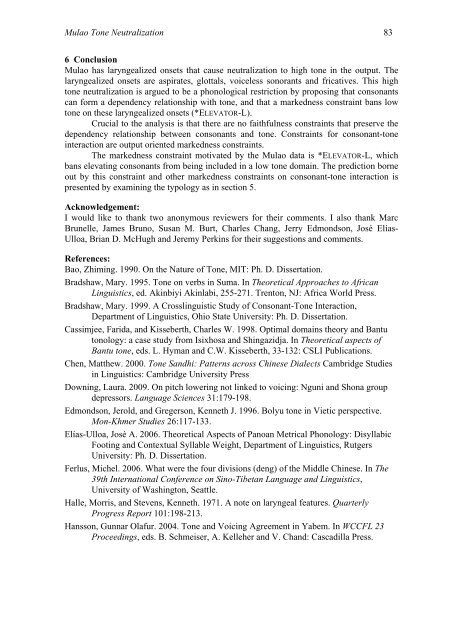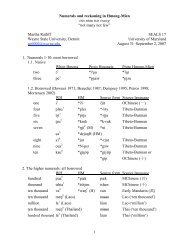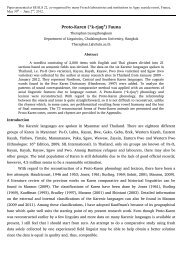proto-southwestern-tai revised: a new reconstruction - seals 22
proto-southwestern-tai revised: a new reconstruction - seals 22
proto-southwestern-tai revised: a new reconstruction - seals 22
You also want an ePaper? Increase the reach of your titles
YUMPU automatically turns print PDFs into web optimized ePapers that Google loves.
Mulao Tone Neutralization 83<br />
6 Conclusion<br />
Mulao has laryngealized onsets that cause neutralization to high tone in the output. The<br />
laryngealized onsets are aspirates, glottals, voiceless sonorants and fricatives. This high<br />
tone neutralization is argued to be a phonological restriction by proposing that consonants<br />
can form a dependency relationship with tone, and that a markedness constraint bans low<br />
tone on these laryngealized onsets (*ELEVATOR-L).<br />
Crucial to the analysis is that there are no faithfulness constraints that preserve the<br />
dependency relationship between consonants and tone. Constraints for consonant-tone<br />
interaction are output oriented markedness constraints.<br />
The markedness constraint motivated by the Mulao data is *ELEVATOR-L, which<br />
bans elevating consonants from being included in a low tone domain. The prediction borne<br />
out by this constraint and other markedness constraints on consonant-tone interaction is<br />
presented by examining the typology as in section 5.<br />
Acknowledgement:<br />
I would like to thank two anonymous reviewers for their comments. I also thank Marc<br />
Brunelle, James Bruno, Susan M. Burt, Charles Chang, Jerry Edmondson, José Elías-<br />
Ulloa, Brian D. McHugh and Jeremy Perkins for their suggestions and comments.<br />
References:<br />
Bao, Zhiming. 1990. On the Nature of Tone, MIT: Ph. D. Dissertation.<br />
Bradshaw, Mary. 1995. Tone on verbs in Suma. In Theoretical Approaches to African<br />
Linguistics, ed. Akinbiyi Akinlabi, 255-271. Trenton, NJ: Africa World Press.<br />
Bradshaw, Mary. 1999. A Crosslinguistic Study of Consonant-Tone Interaction,<br />
Department of Linguistics, Ohio State University: Ph. D. Dissertation.<br />
Cassimjee, Farida, and Kisseberth, Charles W. 1998. Optimal domains theory and Bantu<br />
tonology: a case study from Isixhosa and Shingazidja. In Theoretical aspects of<br />
Bantu tone, eds. L. Hyman and C.W. Kisseberth, 33-132: CSLI Publications.<br />
Chen, Matthew. 2000. Tone Sandhi: Patterns across Chinese Dialects Cambridge Studies<br />
in Linguistics: Cambridge University Press<br />
Downing, Laura. 2009. On pitch lowering not linked to voicing: Nguni and Shona group<br />
depressors. Language Sciences 31:179-198.<br />
Edmondson, Jerold, and Gregerson, Kenneth J. 1996. Bolyu tone in Vietic perspective.<br />
Mon-Khmer Studies 26:117-133.<br />
Elías-Ulloa, José A. 2006. Theoretical Aspects of Panoan Metrical Phonology: Disyllabic<br />
Footing and Contextual Syllable Weight, Department of Linguistics, Rutgers<br />
University: Ph. D. Dissertation.<br />
Ferlus, Michel. 2006. What were the four divisions (deng) of the Middle Chinese. In The<br />
39th International Conference on Sino-Tibetan Language and Linguistics,<br />
University of Washington, Seattle.<br />
Halle, Morris, and Stevens, Kenneth. 1971. A note on laryngeal features. Quarterly<br />
Progress Report 101:198-213.<br />
Hansson, Gunnar Olafur. 2004. Tone and Voicing Agreement in Yabem. In WCCFL 23<br />
Proceedings, eds. B. Schmeiser, A. Kelleher and V. Chand: Cascadilla Press.





